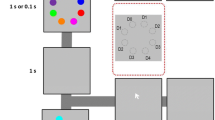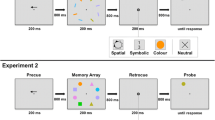Abstract
Recent studies have examined whether the internal selection mechanism functions similarly for perception and visual working memory (VWM). However, the process of how we access and manipulate object representations distributed in a 3D space remains unclear. In this study, we utilized a memory search task to investigate the effect of depth on object selection and manipulation within VWM. The memory display consisted of colored items half positioned at the near depth plane and the other half at the far plane. During memory maintenance, the participants were instructed to search for a target representation and update its color. The results showed that under object-based attention (Experiments 1, 3, and 5), the update time was faster for targets at the near plane than for those at the far plane. This effect was absent in VWM when deploying spatial attention (Experiment 2) and in visual search regardless of the type of attention deployed (Experiment 4). The differential effects of depth on spatial and object-based attention in VWM suggest that spatial attention primarily relied on 2D location information irrespective of depth, whereas object-based attention seemed to prioritize memory representations at the front plane before shifting to the back. Our findings shed light on the interaction between depth perception and the selection mechanisms within VWM in a 3D context, emphasizing the importance of ordinal, rather than metric, spatial information in guiding object-based attention in VWM.






Similar content being viewed by others
References
Ahsan, T., Bolton, K., Wilcox, L. M., & Freud, E. (2021). Perceived depth modulates perceptual resolution. Psychonomic Bulletin & Review, 2. https://doi.org/10.3758/s13423-021-02006-8
Bamford, L. E., Klassen, N. R., & Karl, J. M. (2020). Faster recognition of graspable targets defined by orientation in a visual search task. Experimental Brain Research, 238(4), 905–916. https://doi.org/10.1007/s00221-020-05769-z
Blini, E., Descope, C., Salemme, R., Kabil, A., Hadj-Bouziane, F., & Farnè, A. (2018). Mind the depth: Visual perception of shapes is better in peripersonal space. Psychological Science, 29(11), 1868–1877. https://doi.org/10.1177/0956797618795679
Brainard, D. H. (1997). The Psychophysics Toolbox. Spatial Vision, 10, 433–436. https://doi.org/10.1163/156856897X00357
Carrasco, M., & Chang, I. (1995). The interaction of objective and subjective organizations in a localization task. Perception and Psychophysics, 10, 113–129.
Carrasco, M., Evert, D. L., Chang, I., & Katz, S. M. (1995). The eccentricity effect: Target eccentricity affects performance on conjunction searches. Perception & Psychophysics, 57, 1241–1261.
Chen, H., & Wyble, B. (2015). The location but not the attributes of visual cues are automatically encoded into working memory. Vision Research, 107, 76–85.
Cowan, N. (2001). The magical number 4 in short-term memory: A reconsideration of mental storage capacity. Behavioral and Brain Sciences, 24(1), 87–114.
Cowan, N., & Morey, C. C. (2006). Visual working memory depends on attentional filtering. Trends in Cognitive Sciences, 10, 139–141.
Chunharas, C., Rademaker, R. L., Sprague, T. C., & Brady, T. F. (2019) Separating memoranda in depth increases visual working memory performance. Journal of Vision, 19(1), 4, 1–16
Fang, W., Wang, K., Zhang, K., & Qian, J. (2023). Spatial attention based on 2D location and relative depth order modulates visual working memory in a 3D environment. British Journal of Psychology, 114, 112–131. https://doi.org/10.1111/bjop.12599
Faul, F., Erdfelder, E., Lang, A. G., & Buchner, A. (2007). G*Power 3: A flexible statistical power analysis program for the social, behavioral, and biomedical sciences. Behavior Research Methods, 39, 175–191.
Foster, J. J., Bsales, E. M., Jaffe, R. J., & Awh, E. (2017). Alpha-band activity reveals spontaneous representations of spatial position in visual working memory. Current Biology, 27(20), 3216–3223, e3216.
Fougnie, D., & Marois, R. (2006). Distinct capacity limits for attention and working memory: Evidence from attentive tracking and visual working memory paradigms. Psychological Science, 17, 526–534.
Kong, G., & Fougnie, D. (2019). Visual search within working memory. Journal of Experimental Psychology: General, 148(10), 1688–1700.
Kong, G., & Fougnie, D. (2022). How selection in the mind is different from attention to the world. Journal of Experimental Psychology: General, 151(3), 542.
Kovacs, O., & Harris, I. M. (2019). The role of location in visual feature binding. Attention, Perception, & Psychophysics, 81(5), 1551–1563. https://doi.org/10.3758/s13414-018-01638-8
Lamy, D., & Tsal, Y. (2001). On the status of location in visual attention. European Journal of Cognitive Psychology, 13(3), 305–342.
Li, Z., Tong, M., Chen, S., & Qian, J. (2021). Effect of attentional selection on working memory for depth in a retro-cueing paradigm. Memory & Cognition, 49, 747–757. https://doi.org/10.3758/s13421-020-01123-4
Liu, T., Stevens, S. T., & Carrasco, M. (2007). Comparing the time course and efficacy of spatial and feature-based attention. Vision Research, 47(1), 108–113. https://doi.org/10.1016/j.visres.2006.09.017
Lin, Y., Kong, G., & Fougnie, D. (2021). Object-based selection in visual working memory. Psychonomic Bulletin & Review, 28, 1961–1971. https://doi.org/10.3758/s13423-021-01971-4
Makin, T. R., Holmes, N. P., Brozzoli, C., Rossetti, Y., & Farnè, A. (2009). Coding of visual space during motor preparation: Approaching objects rapidly modulate corticospinal excitability in hand-centered coordinates. Journal of Neuroscience, 29(38), 11841–11851. https://doi.org/10.1523/JNEUROSCI.2955-09.2009
McMains, S. A., Fehd, H. M., Emmanouil, T. A., & Kastner, S. (2007). Mechanisms of feature-and space-based attention: response modulation and baseline increases. Journal of Neurophysiology, 98(4), 2110–2121.
Nakayama, K., & Silverman, G. H. (1986). Serial and parallel processing of visual feature conjunctions. Nature, 320, 264–265.
Norman, J. F., & Todd, J. T. (1998). Stereoscopic discrimination of interval and ordinal depth relations on smooth surfaces and in empty space. Perception, 27(3), 257–272.
Panichello, M., & Buschman, T. (2021). Shared mechanisms underlie the control of working memory and attention. Nature, 592(7855), 601–605. https://doi.org/10.1038/s41586-021-03390-w
Previc, F. H., & Blume, J. L. (1993). Visual search asymmetries in three-dimensional space. Vision Research, 33(18), 2697–2704.
Qian, J., Li, J., Wang, K., Liu, S., & Lei, Q. (2017). Evidence for the effect of depth on visual working memory. Scientific Reports, 7(1), 1–10. https://doi.org/10.1038/s41598-017-06719-6
Qian, J., Li, Z., Zhang, K., & Lei, Q. (2020). Relation matters: Relative depth order is stored in working memory for depth. Psychonomic Bulletin & Review, 27(2), 341–349.
Qian, J., & Zhang, K. (2019). Working memory for stereoscopic depth is limited and imprecise—Evidence from a change detection task. Psychonomic Bulletin & Review, 26, 1657–1665.
Qian, J., Zhang, K., Lei, Q., Han, Y., & Li, W. (2020). Task-dependent effects of voluntary space-based and involuntary feature-based attention on visual working memory. Psychological Research, 84, 1304–1319.
Qian, J., Zhang, K., Wang, K., Li, J., & Lei, Q. (2018). Saturation and brightness modulate the effect of depth on visual working memory. Journal of Vision, 18(9), 16, 1–12.
Reeves, A., & Lei, Q. (2017). Short-term visual memory for location in depth: A U-shaped function of time. Attention, Perception, & Psychophysics, 79, 1917–1932.
Reis, G., Liu, Y., Havig, P., & Heft, E. (2011). The effects of target location and target distinction on visual search in a depth display. Journal of Intelligent Manufacturing, 22(1), 29–41.
Rensink, R. A. (2000). Visual search for change: A probe into the nature of attentional processing. Visual Cognition, 7, 345–376.
Schneegans, S., & Bays, P. M. (2017). Neural architecture for feature binding in visual working memory. The Journal of Neuroscience, 37(14), 3913–3925. https://doi.org/10.1523/JNEUROSCI.3493-16.2017
Sreenivasan, K. K., Gratton, C., Vytlacil, J., & D’Esposito, M. (2014). Evidence for working memory storage operations in perceptual cortex. Cognitive, Affective, & Behavioral Neuroscience, 14(1), 117–128. https://doi.org/10.3758/s13415-013-0246-7
Theeuwes, J. (1989). Effects of location and form cuing on the allocation of attention in the visual field. Acta Psychologica, 72(2), 177–192.
Viswanathan, L., & Mingolla, E. (2002). Dynamics of attention in depth: Evidence from multi-element tracking. Perception, 31, 1415–1437.
Wang, K., Jiang, Z., Huang, S., & Qian, J. (2021). Increasing perceptual separateness affects working memory for depth–re-allocation of attention from boundaries to the fixated center. Journal of Vision, 21(7), 8–8.
Wolfe, J. M. (2007). Guided search 4.0. current progress with a model of visual search. In W. D. Gray (Ed.), Integrated models of cognitive systems (pp. 99–119). Oxford University Press.
Wolfe, J. M., O’Neil, P., & Bennett, S. C. (1998). Why are there eccentricity effects in visual search? Visual and attentional hypotheses. Perception & Psychophysics, 60(1), 140–156.
Xu, Y., & Nakayama, K. (2007). Visual short-term memory benefit for objects on different 3-d surfaces. Journal of Experimental Psychology: General, 136(4), 653–662.
Zhang, K., & Qian, J. (2022). The role of ensemble average differs in working memory for depth and planar information. Journal of Vision, 22(6):4, 1–16, https://doi.org/10.1167/jov.22.6.4
Zhang, K., & Qian, J. (2023). Top-down modulation on depth processing: Visual searches for metric and ordinal depth information show a pattern of dissociation. Psychonomic Bulletin & Review, 30, 1380–1387.
Acknowledgements
This research is supported by the National Natural Science Foundation of China (32271100), and Basic and Applied Basic Research Foundation of Guangdong Province (2021A1515010840) The authors have no competing financial interests that might be perceived to influence the results and/or discussion reported in this paper.
Open practices statement
Data from the experiments and program codes are available online (https://osf.io/z7b6j/). None of the experiments was preregistered.
Funding
Basic and Applied Basic Research Foundation of Guangdong Province,2021A1515010840,National Natural Science Foundation of China,32271100
Author information
Authors and Affiliations
Corresponding author
Additional information
Publisher's Note
Springer Nature remains neutral with regard to jurisdictional claims in published maps and institutional affiliations.
Rights and permissions
Springer Nature or its licensor (e.g. a society or other partner) holds exclusive rights to this article under a publishing agreement with the author(s) or other rightsholder(s); author self-archiving of the accepted manuscript version of this article is solely governed by the terms of such publishing agreement and applicable law.
About this article
Cite this article
Qian, J., Fu, B., Gao, Z. et al. The influence of depth on object selection and manipulation in visual working memory within a 3D context. Psychon Bull Rev (2024). https://doi.org/10.3758/s13423-024-02492-6
Accepted:
Published:
DOI: https://doi.org/10.3758/s13423-024-02492-6




